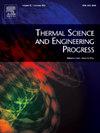Lateral conduction effect study using 2-D transient liquid crystal measurement
IF 5.1
3区 工程技术
Q2 ENERGY & FUELS
引用次数: 0
Abstract
In most liquid crystal thermography (LCT) based heat transfer investigations, one-dimensional (1-D) conduction solution for semi-infinite wall is widely used to determine surface heat transfer coefficients (HTCs). The conventional 1-D solution ignores the transverse and longitudinal variation of surface temperature values, which makes HTCs prone to lateral conduction errors. Accounting the lateral conduction effect demands full-scale multidimensional boundary conditions, which is seldom possible in Liquid Crystal (LC) experiments. Present investigation is a forward step in that direction and performs comprehensive analysis to evaluate the lateral conduction effect with the help of actual LC measurements. Investigations have been performed at different Reynolds number for the duct carrying smooth surface and surface mounted with different types of turbulence promoters, i.e., round-edged perforated rib (2-D rib) and truncated prismatic rib (3-D rib), which are supposed to produce two/three-dimensionality in flow field and hence the lateral conduction effects. Eventually, 2-D and 3-D conduction results are compared against 1-D results. Accuracy and reliability of transient conduction scheme is also reviewed by varying several inherent parameters. For undisturbed flow (smooth duct), 1-D solution (wall normal, y-direction) under predicts HTC as against the transverse spanwise (2-D), longitudinal streamwise (2-D), and full scale multidimensional (3-D) conduction results by ∼ 7–9 %, 2–4 %, and 8–12 %, respectively. 2-D conduction-based (transverse or longitudinal) solution fails to predict the actual HTC distribution in vortex induced flow condition (ribbed duct). 3-D conduction-based analysis accurately capture the small-scale HTC distribution pattern, and yields 10–13 % higher HTC values as against conventional 1-D semi-infinite conduction-based solution.
求助全文
约1分钟内获得全文
求助全文
来源期刊

Thermal Science and Engineering Progress
Chemical Engineering-Fluid Flow and Transfer Processes
CiteScore
7.20
自引率
10.40%
发文量
327
审稿时长
41 days
期刊介绍:
Thermal Science and Engineering Progress (TSEP) publishes original, high-quality research articles that span activities ranging from fundamental scientific research and discussion of the more controversial thermodynamic theories, to developments in thermal engineering that are in many instances examples of the way scientists and engineers are addressing the challenges facing a growing population – smart cities and global warming – maximising thermodynamic efficiencies and minimising all heat losses. It is intended that these will be of current relevance and interest to industry, academia and other practitioners. It is evident that many specialised journals in thermal and, to some extent, in fluid disciplines tend to focus on topics that can be classified as fundamental in nature, or are ‘applied’ and near-market. Thermal Science and Engineering Progress will bridge the gap between these two areas, allowing authors to make an easy choice, should they or a journal editor feel that their papers are ‘out of scope’ when considering other journals. The range of topics covered by Thermal Science and Engineering Progress addresses the rapid rate of development being made in thermal transfer processes as they affect traditional fields, and important growth in the topical research areas of aerospace, thermal biological and medical systems, electronics and nano-technologies, renewable energy systems, food production (including agriculture), and the need to minimise man-made thermal impacts on climate change. Review articles on appropriate topics for TSEP are encouraged, although until TSEP is fully established, these will be limited in number. Before submitting such articles, please contact one of the Editors, or a member of the Editorial Advisory Board with an outline of your proposal and your expertise in the area of your review.
 求助内容:
求助内容: 应助结果提醒方式:
应助结果提醒方式:


